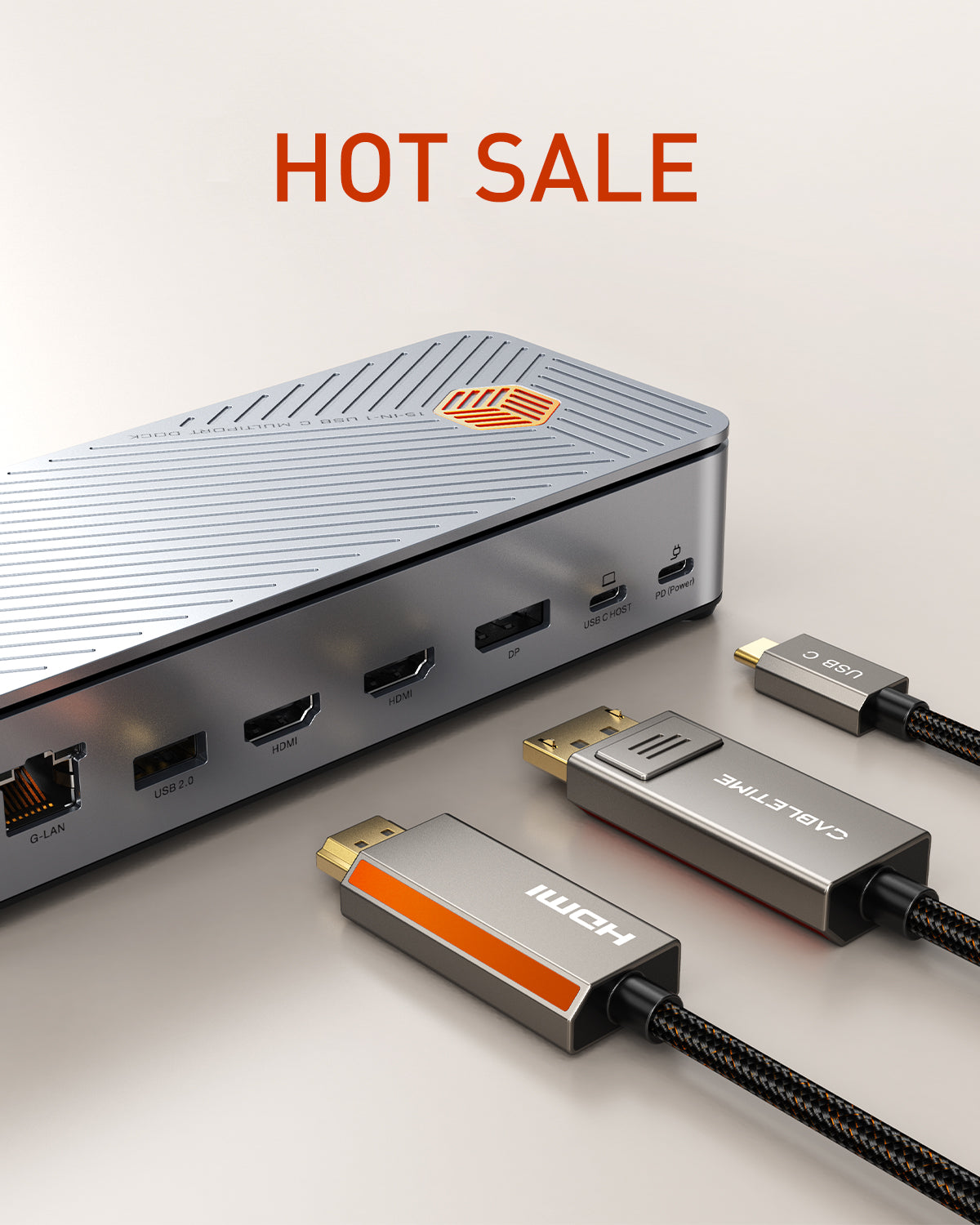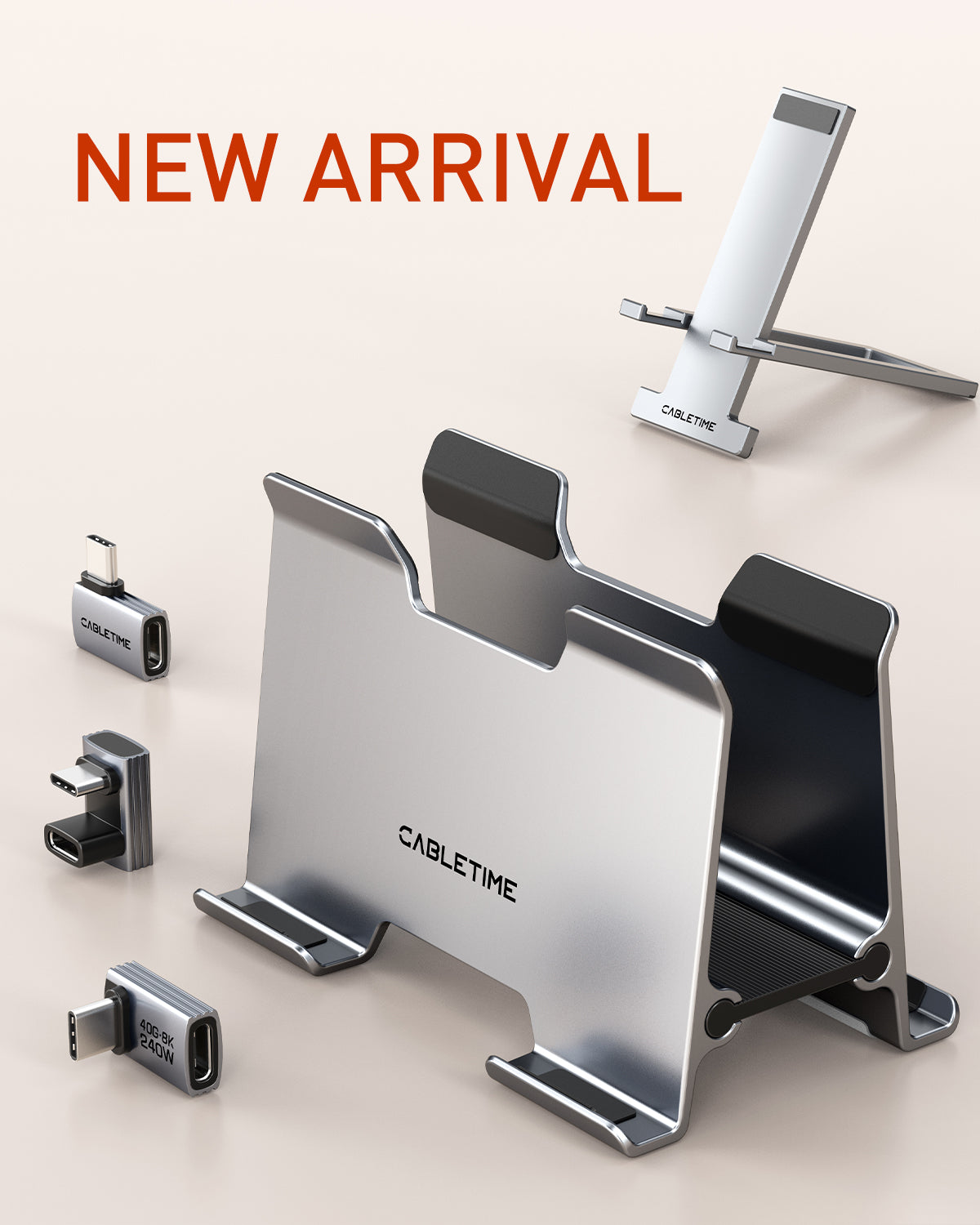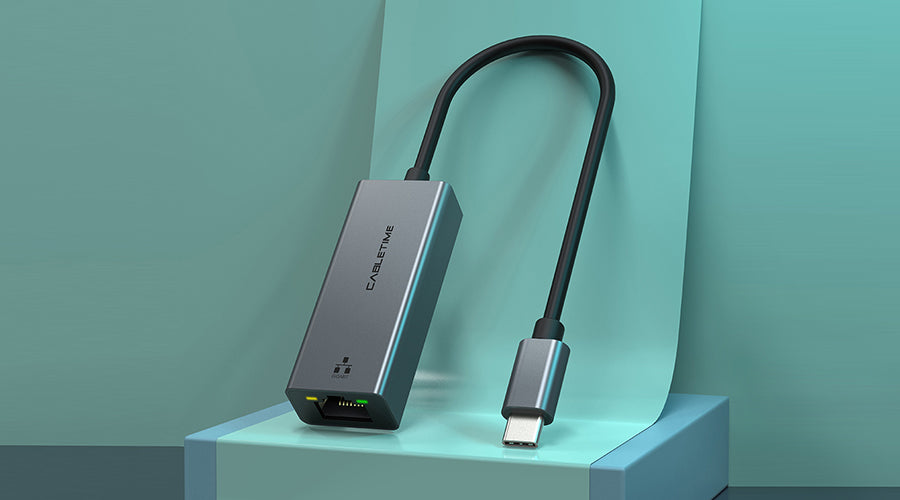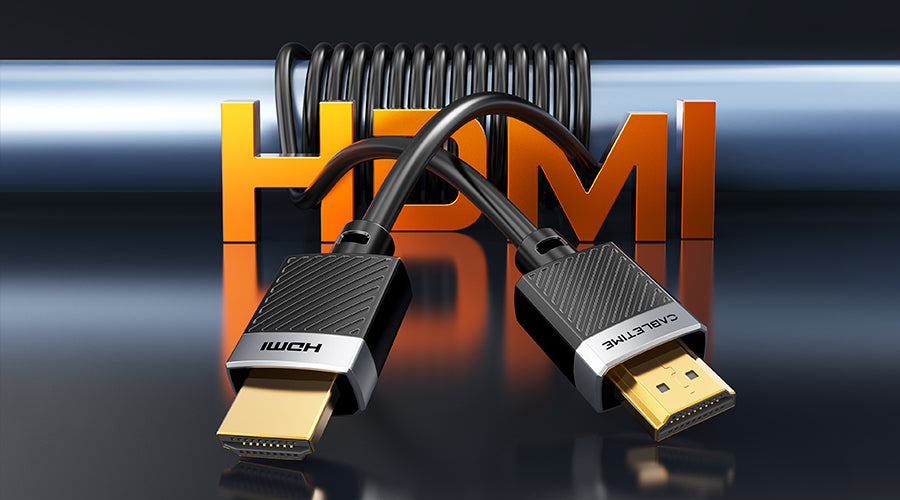Are you tired of network interruptions, fluctuating download speeds, stream lags, and gaming ping issues from your WiFi connection? In an era of ubiquitous wireless networks, wired connections remain significant for their reliable speed and stability.
This article will guide users who need to connect an Ethernet cable to laptops that do not feature an on-board Ethernet port. Laptops are daily drivers of every progressing organization utilizing a work-from-home or on-site work policy.
If your mobile PC comes equipped with an Ethernet port, all you need to do is insert the Ethernet cable into this port and connect the other end to your router, and you are good to go. However, if your device doesn’t have a built-in ethernet port, there is no need to worry! Ethernet adapters and USB hubs can convert USB-C or USB-A ports to an RJ45 ethernet port. Let's discover how we can connect the ethernet cable to your laptop with no ethernet port!
Table of content

Getting Started
The popularity of Wi-Fi and the demand for sleek and lightweight laptops have resulted in the discarding bulky connectivity solutions for modern devices. However, improved connectivity solutions offset these changes, and it's essential to know which of them your laptop offers.
To connect your laptop to an ethernet port, you will require the following:
- Compatible Ports
- Compatible Operating System
- Ethernet Adapter
- Ethernet Cable
Let's build a basic understanding of these requirements to find your laptop's ethernet adapter or USB hub.
USB-A or USB-C Ports
USB 2.0, USB 3.0, USB 4, and Thunderbolt interface can quickly achieve Ethernet connectivity. Almost all laptop manufacturers equip their devices with a USB-A interface, which offers a very cheap and easy solution to ethernet connectivity. Here is a list of standard ports available on laptops:
- USB 2.0:A rectangular-shaped port that connects the keyboard and mouse.
- USB 3.0:This is a high-speed version of USB, similar to USB 2.0, but with added blue filling; these ports are usually smaller than USB 2.0.
- USB Micro:A small D-shaped port is standard for major mobile devices and TV sticks.
- USB Type C: Small Symmetrical oval-shaped port.
- Thunderbolt:Same as a USB type C port but has lighting marking.
Here is a table highlighting USB types, their symbols, data transfer speeds, and ethernet compatibilities:
|
USB Type |
Symbol |
USB Port Speed |
Ethernet Compatibility |
|
USB 2.0 (High-Speed) |
|
480 Mbps |
Up to Fast Ethernet 10/100Mbps |
|
USB 3.2 |
|
5 Gbps |
Up to Gigabit Ethernet 1000Mbps |
|
USB 3.1 Type-C |
|
10Gbps |
Up to Gigabit Ethernet 1000Mbps |
|
USB Type C Thunderbolt |
|
40 Gbps |
Up to 10-Gigabit Ethernet 10Gbps |
|
USB4 |
|
40 Gbps |
Up to 10-Gigabit Ethernet 10Gbps |
Operating System
The next item you need to check is the operating system. Operating systems like Windows, Mac OS, and Linux Distributions come preloaded with drivers compatible with the ethernet adapter. If your card driver is not pre-installed with your OS, the ethernet adapter manufacturers will provide the driver with the package. Ensure that the adapter you aim to purchase mentions your device's operating system under specifications.
Ethernet Adapter
A wide range of ethernet adapters are available in the market, tailored to meet users' diverse requirements. It is essential to choose which adapter is suitable for your specific needs. From cheap day-to-day use options to costly high-speed gaming options, there are a variety of adapters to choose from. However, selecting the suitable ethernet adapter may require a threshold of knowledge for compatibility. We will mention these nuances later in the guide.
Ethernet Cable
Lastly, you will require an ethernet cable to connect two devices. The market offers options from Cat-6 (the most familiar and well-suited for modern applications) to the advanced Cat-8 cables (used in High-Speed and Expensive data centers and similar applications) depending on your speed requirements.
Further, you can choose armored cables with thick outer covering for better protection from harsh environments, slim or ultra-slim options for better concealment and cable management in small spaces, and flat cables ideal for running under carpets and doors.

Selecting the Right Ethernet AdapterThings to consider while choosing an ethernet adapter:Connection SpeedAdapter ConnectivityUSB Hub or Docking StationAdapter CompatibilitySize and PortabilityConnection SpeedThe most common type of ethernet adapter is a USB-to-ethernet adapter. These adapters come with a wide range of USB support up to USB 3.0 and Type C. A high-speed USB 3.1 Type C LAN adapter can support speeds of up to 2.5Gbps, but why spend money on features and speed you can’t use?. There are mainly two uses for high-speed connection: Office Use:For intranet connectivity and file sharing, which most organizations utilize. Higher bandwidth means improved efficiency and time-saving. With a 2.5Gbps connection, users can transfer a 10GB file within approx 32 seconds. Home Use:If your internet connection has a bandwidth of 50 Mb/s, a USB 2.0 ethernet adapter will deliver the same performance with its 100 Mb/s limit.Adapter ConnectivityUSB ethernet adapters come with multiple connectivity options. With manufacturers moving towards slim and portable designs, the number of USB ports available on a laptop is limited, and sparing a USB port for ethernet connectivity may be a cause of concern when you require connecting additional devices like keyboards, mice, external storage drives, or other peripherals to your laptop.The most common USB 2.0 adapters are capable of a maximum of 100Mbps data transfer speed, while USB 3.0 Ethernet adapters usually offer speeds up to Gigabit Ethernet Limits, i.e., 1000Mbps. A thunderbolt ethernet adapter can achieve a speed of 10-Gigabit Ethernet Limits i.e. 10GbpsIf your connection bandwidth is below 450 Mb/s, it is advisable to connect the Ethernet adapter to a USB2.0 port and leave the high-speed USB3.0/Type-C for other devices. Users can connect the Ethernet adapter to a USB hub.USB Hub or Docks with built-in Ethernet AdaptersUSB Hubs with Built-in Ethernet AdaptersManufacturers offer USB hubs and docks for users with enhanced connectivity needs. USB hubs increase the number of USB and other ports on your computer by connecting to a single USB port. They are available in USB 2.0, USB 3.0, Micro USB, and Type-C compatibility. Some USB hubs come with built-in ethernet adapters to cater to user needs.USB Docking StationsA USB Dock, on the other hand, is an externally powered device with multiple ports (USB, HDMI, Ethernet, SD Card, M2 NVMe) to increase a laptop's connectivity. USB docks also connect to a single USB port. Some USB docks also provide multiple ethernet ports and can be helpful if numerous ethernet connections are required.Dos and Don'ts of USB Hub/DocksUSB hubs and docks are versatile tools that allow users to enhance their connectivity. However, they connect to a single USB port. A USB 3.2 Gen 2 offers a bandwidth of up to 20 Gbps, which all devices connected to the USB hub or dock will share. It may lead to degraded ethernet performance during the peak load of the devices connected.USB hubs and docks perform well for almost all daily tasks, such as streaming, surfing, social networking, video conferencing, office meetings, and sharing. If your ethernet is under 1000 Mbps, then a USB hub or dock will work like a standalone ethernet adapter.Users can opt for a standalone ethernet adapter to transfer high volumes of data, such as in data center applications. Applications with speed requirements corresponding to 10 Gbps may face a degraded operation with a USB hub ethernet adapter.Adapter CompatibilityMost ethernet adapters are plug-and-play, as the drivers are already pre-installed with the operating system. Newer OS versions, like Windows, Macintosh, and Linux, offer plug-and-play compatibility with almost all available products.As a backup, most ethernet adapter manufacturers also provide the required drivers with the device package.OS like ChromeOS, Raspberry Pi OS, Android, and iOS may require specific ethernet adapters that are compatible with them.Ethernet adapters are compatible with Android 6, Marshmallow, or higher only. Connecting ethernet adapters to Android requires switching off the cellular and wifi connections (Airplane Mode). Remember that some apps won’t work with ethernet adapters and need a cellular or wifi connection to function.Size and PortabilityFor modern users, portability and compactness are essential. Ethernet adapters are available in various sizes, shapes, and form factors.Dongle Style AdaptersThese adapters resemble a USB memory stick, which is excellent for small-space applications and portability.Cabled AdaptersCabled adapters come with a cord with a USB port on one side and a small boxed adapter with an RJ45 port on the other. They are suitable for mobility and convenience but don’t offer the same compactness as dongle-style adapters.Multifunction AdaptersMultifunction adapters usually have USB-C port connectivity, and offer added HDMI and USB connectivity. They are suitable for saving USB ports on a laptop or mobile device and for ethernet connectivity.Establishing a Wired ConnectionChoosing the Suitable Ethernet cableChoosing the cable that is suitable for your needs will save money and time. Standard Ethernet cables are Cat5, Cat6, and Cat8.Cat5Cat 5 cables are the cheapest and support a bandwidth of 100Mbps. They are a good choice if your connection is below this threshold and you don't intend to upgrade soon. Cat 5 corresponds to the limit of USB 2.0 adapters.Cat6Cat6 offers speeds up to 1Gbps, while the advanced Cat6a gives speeds up to 10Gbps.Cat8Cat8 is more expensive and offers a bandwidth of 25~40 Gbps. However, due to added shielding, Cat8 cables are pretty thick, making them difficult to install in tight spaces.Connecting the adapter to the Ethernet cableConnecting an ethernet cable to the adapter is straightforward and doesn’t require shutting down the devices involved. An ethernet cable has two male RJ45 ends, which go into a female RJ45 port. The top of the connector has a latch that goes into the port and makes a clicking sound when correctly inserted. Once both ends are connected, orange and yellow lights on the female ports glow/blink, showing the connection is complete.Configuring Network SettingsConfirming the network connectionLED Indication on PortMost devices have orange and yellow LEDs that light up when connected. If your laptop or device has these, check that the LEDs are glowing.Windows OSWindows 10 and 11 have a network icon in the shape of a globe. When you hover the cursor above that icon, it will show the connection status. The status can also be verified by typing “View Network Connection” in search, which will open a window with all network adapters and show their connection status.MacOSThe menu bar has an ethernet network icon “<...>” which becomes bold when connected to ethernet. Additionally, from the Apple menu, go to “System Preferences” → “Network,” and there will be a green dot next to the active ethernet connection.Networking setup for Windows and macOSDHCP EnabledIf DHCP is enabled, the network sets up automatically as the user plugs in the ethernet cable, and no further setup is required. However, if DHCP is not enabled, the network must be manually set up by following the following steps.WindowsGo to “Control Panel” → “Network and Internet” → “Network and Sharing Center” → “Change Adapter Settings” a window will open showing all the network adapters.Right-click on the ethernet adapter and open “Properties.” In the properties window, double-click “Internet Protocol Version 4 (TCP/IPv4).”In the popup window, select “Use the following IP addresses” and enter the IP address, subnet mask, default gateway, and DNS server address. Click OK to save and exit.MacOSFrom the Apple menu, go to “System Preferences” → “Network,” and from the list of connections on the left, select “Ethernet.”From the “Configure IPv4” dropdown menu, select Manually and enter the IP address, subnet mask, router gateway, and DNS server address. Click Apply to save, and then exit the menu.Troubleshooting and OptimizationCable Connection IssueSymptoms: LEDs don’t glow when the cable connects with the port.Possible Solutions:Check that the cable firmly fits inside the port.Check for damage on the male connector.Try connecting the cable to another device to check the connector's healthiness.Try switching to another port on the router.Driver IssueSymptoms: The adapter is not recognized or doesn’t show up on available Network devices.Possible Solutions:Check that the driver is the same version that was declared compatible by the manufacturer with your version of OS.Try updating the driver to the latest available by the manufacturer.Uninstall the driver, restart the system and reinstall the driver.Cable DamageSymptoms: The cable frequently connects and disconnects when moving, and there are visible cuts, bend marks, and damage to the cable.Possible Solutions:Replace the cable with a known working cable and see if it resolves the problem.Remove the damaged part of the cable and reattach the connector.Bandwidth LimitationsSymptoms: Slow data transfer on intermittent connectivity, especially during peak hoursPossible Solutions:Consider upgrading your network equipment.Contact ISP for further troubleshooting.Upgrade your subscription with your ISP.Configuration IssuesSymptoms: Incorrect IP address, subnet mask, and DNS gateway settings.Possible Solutions:Use DHCP for automatic network settingsDouble-check your settings with the one provided by the ISP.If multiple devices have the same IP address, release the IP address from all devices except one.ConclusionModern compact laptops don’t offer an ethernet port, but it is a must for some. USB ethernet adapters allow users to connect to an Ethernet network without the hassle of buying another device with an ethernet port. Modern ethernet adapters offer speeds up to 10Gbps with 10 Gigabit Ethernet and Cat8 cable support. USB ethernet adapter provides easy connectivity with USB 2.0/3.0/Type-C and Thunderbolt support. Be it large data transfer, 4K streaming, or low latency gaming, USB ethernet adapters offer the stability and reliability of ethernet connection to modern sleek and slim devices with its wide range of connectivity and platform support.People Also AskWhat kind of Ethernet cable do I need to connect my laptop to my router?Users can utilize any ethernet cable from Cat3 to Cat8 with an RJ45 connection to the laptop with an ethernet router. Cat 6 cables support Gigabit Ethernet and are sufficient to fulfill the daily needs of the common user.Why do new laptops not have Ethernet ports?Modern laptops are built for compactness and portability, allowing for less space for ports and connectivity solutions. Most modern laptops come with USB-C ports, enabling users to connect various devices. They can utilize Thunderbolt 4 or USB 4 protocol to tunnel DP, PCIe, Ethernet, etc through a single USB port. If a user needs expansion of ports, they can opt for a 15-in-1 docking station.Should I turn off WiFi when using Ethernet?Turning the WiFi ON or OFF depends upon your requirements. Users can share the ethernet connection via WiFi and mobile devices. WiFi and Ethernet use separate hardware and do not interfere with one another’s operation.I don’t know much about Ethernet and Bandwidth. Which adapter should I buy for the best performance?Go for any ethernet adapter that offers Gigabit Ethernet 1000Mbps support or higher. Gigabit Ethernet is sufficient to cover the everyday needs of a common user. Specialized applications, such as data centers, that require high-speed connectivity require more upgraded hardware.Can I connect multiple ethernet connections to a single USB port?Yes, products that allow multiple ethernet connections to a single USB port are available. However, the USB interface's maximum speed limits the bandwidth available on each ethernet port. A USB-C port with USB 4 or Thunderbolt 4 can provide 40Gbps data transmission speed. Make sure your laptop or PC has a high-speed USB-A or USB-C port.Can I use my laptop as a Wi-Fi router with Ethernet Adapter?You can use your laptop as a Wi-Fi router with an ethernet adapter. Just plug your adapter and ethernet cable into your laptop or ethernet adapter. To turn on Wi-Fi Hotspot sharing, right-click on the Windows Start Icon in the taskbar, then click Settings > Network & Internet > Mobile hotspot.Can I use a USB Ethernet adapter for gaming applications?Modern USB ethernet adapters support up to 10Gb ethernet, allowing for seamless gameplay and low latencies. Due to higher stability and low signal loss, the gaming experience on an ethernet connection is generally superior to a WiFi connection. Also, ethernet is less expensive to set up than a gaming WiFi router.Can I share my Wi-Fi via a USB Ethernet Adapter?Yes, USB ethernet adapters can share Wi-Fi connections. However, you will need to configure the adapter for Network sharing and allow connection sharing on the Wi-Fi adapter.Go to the Network and Sharing Center → "Change adapter settings." Right-click on the Wi-Fi adapter → "Properties." → Click the "Sharing" tab and check the box "Allow other network users to connect through this computer's Internet connection."








Leave a comment
This site is protected by hCaptcha and the hCaptcha Privacy Policy and Terms of Service apply.